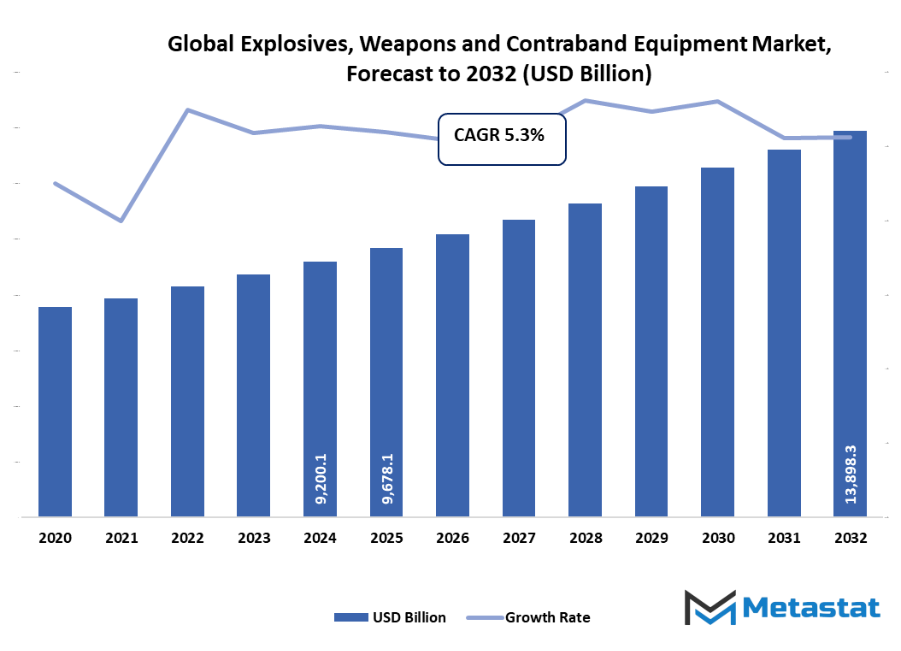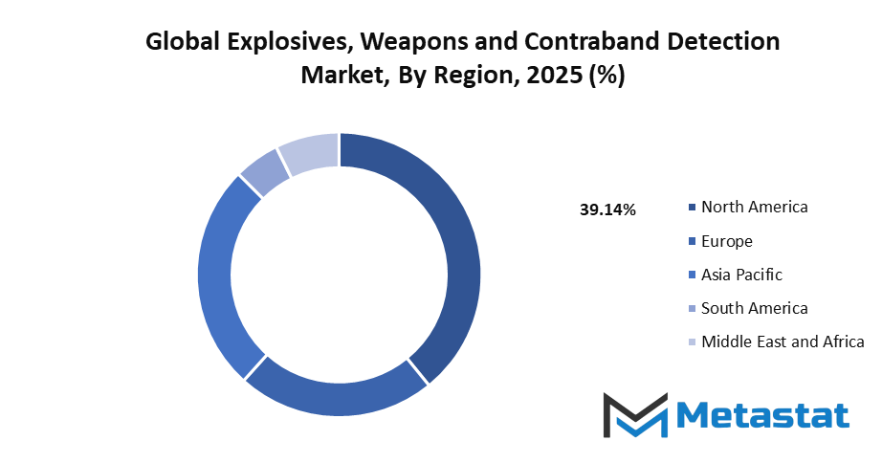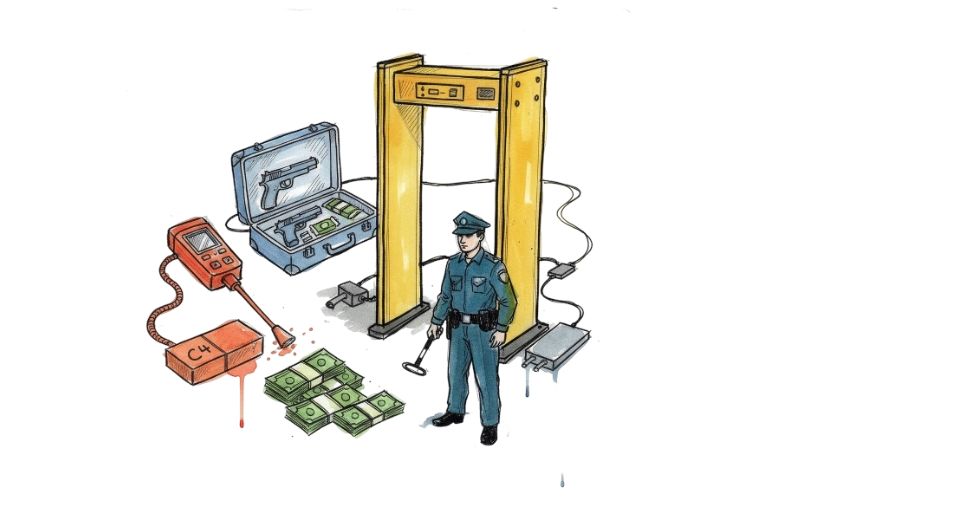Global Explosives, Weapons and Contraband Detection Equipment Market - Comprehensive Data-Driven Market Analysis & Strategic Outlook
- Global explosives, weapons and contraband detection equipment market valued at approximately USD 9678.1 billion in 2025, growing at a CAGR of around 5.3% through 2032, with potential to exceed USD 13898.3 billion.
- Explosives Detection Equipment account for a market share of 50.7% in 2024, driving innovation and expanding applications through intense research.
- Key trends driving growth: Rising global terrorism threats and security concerns, Increasing government investments in airport and border security infrastructure
- Opportunities include: Integration of AI and machine learning offers enhanced detection accuracy and efficiency
- Key insight: The market is set to grow exponentially in value over the next decade, highlighting significant growth opportunities.

Market Background & Overview
The global explosives, weapons and contraband detection equipment market are going to be a major contributor to the security & defense industry market. This market will deliver advanced solutions to identify and eliminate threats in public, private, and military spaces. The market will have different types of advanced detection systems, for example, X-ray scanners, and metal detectors, as well as trace detection, explosive detection portals, and integrated sensor technologies that are designed to stop safety risks and prevent unauthorized or hazardous items from entering secure areas.
This market would be utilized in many different ways, and examples of those ways are the airports, seaports, border checkpoints, transportation hubs, correctional facilities, law enforcement agencies, and military installations. The need for real-time threat identification and high-accuracy detection will be the main reason for the integration of automated scanning, AI-based analytics, and sensor fusion technologies. These improvements will allow security officers to find a wide range of explosives, firearms, narcotics, and other contraband with great accuracy and less human intervention.
Moreover, the global explosives, weapons and contraband detection equipment market will be impacted positively with the main focus on counterterrorism, public safety, and regulatory compliance. The manufacturers of the equipment are going to focus on improving the detection's sensitivity, and at the same time, reducing false alarms, and also developing solutions that are portable and scalable and can easily adapt to different operational requirements. The market will allow security to use the most advanced technology and at the same time to be efficient in operations. In this way, the market will be helping the governments, organizations, and private entities to have safer environments. They will be playing a major role in public safety through their continuous advancements and will also be limiting the security risks that exist in these high-risk places all over the world.
Market Segmentation Analysis
The global explosives, weapons and contraband detection equipment market is mainly classified based on Type, Technology, Application, End-User.
By Type is further segmented into:
- Explosives Detection Equipment: Explosives detection systems are the first line of defense to avoid the occurrence of terrorist attacks, protect vital infrastructures, and ensure the security of the general public in various places. The next innovations will mainly concentrate on small, super-sensitive, and rapid detection devices that will be used for a more extended deployment in transport hubs and other places considered at high risk.
- Weapons Detection Equipment: Weapons detection devices are found in airports and other government buildings, and they are also used at security checkpoints in various public venues to locate firearms as well as knives. The improvements in speed, accuracy, and AI analytics will help operational settings to detect a more extensive range of threats and make quicker decisions.
- Contraband Detection Equipment: Contraband detection equipment is designed to identify illegal substances such as drugs that may be hidden in a smuggled product and any other hazardous materials. The new technologies will also allow for the integration of real-time non-intrusive detection together with the increased accuracy of customs, border protection, and law enforcement personnel worldwide.
By Technology the market is divided into:
- Ion Mobility Spectrometry (IMS): IMS is the first choice for explosives and chemical detection, where the main criteria are quickness and portability. Futuristic trends include sensors that are miniaturized, more sensitive, and better integrated with automated monitoring systems to provide faster real-time threat detection.
- Computed Tomography (CT): With CT technology, advanced 3D imaging for baggage and cargo screening can be achieved. The Global Explosives, Weapons, and Contraband Detection Equipment Market is going to be impacted by the coming of faster, high-resolution scanners that can detect concealed threats with little or no disturbance to the flow of work.
- X-ray Imaging: Security screening heavily relies on X-ray imaging which is the main support. Developments in dual-energy and AI-assisted X-ray systems will result in higher detection accuracies, less false alarms, and faster throughput in airports, seaports, and areas under strict security will be enabled.
- Raman Spectroscopy: The use of Raman spectroscopy enables the accurate determination of chemical compounds found in explosives or narcotics. In the future, its use will become more widespread in portable instruments, thus simplifying on-site inspections and making the operational work of law enforcement and defense agencies faster.
- Mass Spectrometry: Mass spectrometry is the most trustworthy method for chemical analysis which is however becoming more and more integrated into laboratory and field-based security applications. Automated sampling and rapid processing will be the main factors of growth in the respective sectors of defense and public safety.
- Laser Induced Breakdown Spectroscopy (LIBS): LIBS is a technology that utilizes a laser to break down the material thus providing the fastest elemental identification for the extremely dangerous field of explosives and hazardous materials. The coming portable LIBS devices will be the ones to back up the field operations with quicker and non-destructive methods of testing for the security and defense institutions.
By Application the market is further divided into:
- Transportation Security: Detection systems are the backbone of airports, seaports, and railways. Future solutions will concentrate on automated, high-throughput scanning that allows the seamless integration of AI and IoT to enhance flow and assure passenger and cargo safety.
- Critical Infrastructure Protection: Screening technologies serve as the first line of defense against power plants, government facilities, and industrial sites. The inventions will allow threat alerts in real-time, prediction of the crisis, and proactive action to stop security breaches.
- Military and Defense: Among military applications, the most advanced detection of explosives, weapons, and contraband is required. The coming of portable, rugged, and accurate systems will lead the market growth for tactical and battlefield scenarios.
- Public Safety and Law Enforcement: Detection technologies have been incorporated by law enforcement agencies as a measure to keep an eye on public spaces and events. AI-powered systems, along with mobile scanning units, will avail themselves for rapid deployment and thus facilitate efficient threat response.
- Border Security: Advanced detection equipment is relied upon by border security for the control of illegal trade and smuggling. The advent of highly portable and automated solutions will not only boost surveillance, but also help to considerably cut down on manual inspection time, thereby tightening national security measures.
By End-User the global explosives, weapons and contraband detection equipment market is divided as:
- Government and Military Agencies: Government and military organizations are among the major users who make a considerable investment in the advanced detection systems that are required to increase the national security level, safeguard the vital infrastructure, and also support the tactical operations worldwide.
- Airport and Border Security: Intelligent screening systems are employed in airports and border checkpoints in order to find explosives, weapons or smuggled products. The future implementation will be concentrated on AI-driven automatic screening and the unobtrusive integration with global security networks.
- Commercial Security: Detection systems are becoming the main technological trend for commercial establishments such as shopping centers, corporate offices, or entertainment venues. The development of technology will grant the rise of solutions that are both cost-effective and efficient in maintaining safety without compromising the flow of customers.
- Customs and Immigration: Detection technologies are used by customs and immigration officials for cargo and passenger screening. The appearance of portable and high-speed devices will tank inspection with higher accuracy and operational efficiency that will surely reduce the risk of smuggling and illegal trade.
|
Forecast Period |
2025-2032 |
|
Market Size in 2025 |
$9678.1 Billion |
|
Market Size by 2032 |
$13898.3 Billion |
|
Growth Rate from 2025 to 2032 |
5.3% |
|
Base Year |
2024 |
|
Regions Covered |
North America, Europe, Asia-Pacific, South America, Middle East & Africa |
By Region:
The global explosives, weapons and contraband detection equipment market will hold different regional dynamics that are influenced by security infrastructure, regulatory frameworks, and defense priorities. The U.S., Canada, and Mexico which constitute North America will be at the forefront as they have made extensive investments in homeland security, advanced airport screening systems, and military-grade detection technologies. The region will be mainly concerned with the implementation of AI-driven analytics, automated scanning, and high-sensitivity sensors in order to maintain security that is both strong and reliable across the public and private sectors.
By modernizing border control, transportation hubs, and critical infrastructures, Europe, the UK, Germany, France, Italy, and other countries will achieve their goals. Requirements for regulatory compliance, implementation of anti-terrorism directives, and establishing public safety protocols will lead to a rise in the need for sophisticated, portable and scalable detection solutions. Government and private sector in Europe will use the integrated technologies to optimize security operations and increase managerial productivity.
The global explosives, weapons and contraband detection equipment market will be a high-growth market in Asia-Pacific that consists of India, China, Japan, South Korea, and the rest of the region mainly because of rapid urbanization, growing transport networks and security awareness, South America that is made up of Brazil and Argentina will use detection devices for border security, public events, and urban safety initiatives while the Middle East and Africa, including the GCC countries, Egypt and South Africa, will install the most advanced threat detection at airports, seaports, and military zones. The global explosives, weapons and contraband detection equipment market will be present in all regions and will be transformed by breakthrough innovations, tightened security measures, and operational efficiency which will be the factors responsible for the worldwide elimination of threat and the assurance of people's safety.

Market Dynamics
Growth Drivers:
- Rising global terrorism threats and security concerns: Such a situation as global terrorism, which is on the rise, fear, etc is among the major growth drivers of the Global Explosives, Weapons, and Contraband Detection Equipment Market. In order to prevent or at least minimize the risk of terror attacks occurring in places where large numbers of people congregate (for example, airports, railway stations, etc.) governments and organizations are making safety screening solutions a priority. Therefore, this trend is keeping the manufacturers of the security equipment at a stable pace of development all over the world.
- Increasing government investments in airport and border security infrastructure: The influx of government money aimed at building airport and border security infrastructure goes a long way in supporting market expansion. The establishment of contemporary scanning facilities, purchase of the most technologically advanced detection instruments, and the upgrading of the existing systems are the three pillars that form the basis for ensuring operational efficiency and safety, which leads to the acceptance of districts with the most considerable number of travelers and trade volumes.
Restraints & Challenges:
- High installation and maintenance costs limit adoption in developing regions: Big installation and maintenance costs prevent the use of the technologies in poor areas. The Global Explosives, Weapons, and Contraband Detection Equipment Market is suffering from a lack of money especially in those places where limited infrastructure and budget put organizations in a position where they cannot implement advanced detection systems and maintain operational readiness.
- Privacy concerns and regulatory hurdles in surveillance and scanning technologies: Privacy issues and bureaucratic obstacles also obstruct the progress of surveillance and scanning technologies. Legal limitations, public willingness to accept, and conformity with international regulations can delay deployment, thus requiring an exact approach to ethical and regulatory problems both in the area of the country and in the cross-border operations.
Opportunities:
- Integration of AI and machine learning offers enhanced detection accuracy and efficiency: The implementation of AI and machine learning has the potential to provide the Global Explosives, Weapons, and Contraband Detection Equipment Market with improved detection accuracy and efficiency. The smart algorithms can facilitate threat identification without human involvement, lower the number of false alarms, and open up security measures that are predictive, as a result of which the sector will be energized for its future innovation and ripe for application in various areas such as transportation, defense, and the safety of the public.
Competitive Landscape & Strategic Insights
On one hand, the global explosives, weapons and contraband detection equipment market landscape will be a combination of well-known established international leaders and flexible regional players/change agents, bringing about a very competitive atmosphere, which would focus on technological breakthroughs and better operational efficiency. The mentioned key competitors namely Morphix Technologies, FLIR Systems, General Electric, OSI Systems, L3 Technologies, Smiths Group, Detectnology, Chemring Group, Polimaster, Cobham, Autoclear, and Patriot One Technologies will not only keep setting the trends for this market but also be the first movers in this market through the implementation of advanced detection systems like X-ray, trace detectors, and integrated sensor technologies. These companies will be deploying AI-driven analytics, real-time monitoring, and automated scanning to not only improve accuracy but also to reduce the number of false alarms and maximize the operational workflows.
The rising regional competitors will find their place by providing inexpensive, portable, and niche detection solutions, which can be used locally and are suitable for urban transport hubs and border control operations. With their adaptability and dedication to the niche market, their offerings will become the perfect match for those of big global players and, as a result, keep the sparks of innovation and the further extension of the range of the detection ongoing.
Basic and macro-level decisions will be to bank on integrated digital platforms, IoT-enabled sensors, and AI-assisted threat analysis for the future of the global explosives, weapons and contraband detection equipment market. System's scalability will become the main focus, where companies will work on making it more sensitive to detection and developing easy-to-use interfaces to handle the constantly changing security requirements. By combining the best global expertise with localized solutions, the market will be able to deliver safety in the most comprehensive way, efficient threat alleviation and dependable security infrastructure not only in airports but in seaports, at the borders, in critical facilities and public spaces all over the globe.
Forecast & Future Outlook
- Short-Term (1–2 Years): Recovery from COVID-19 disruptions with renewed testing demand as healthcare providers emphasize metabolic risk monitoring.
- Mid-Term (3–5 Years): Greater automation and multiplex assay adoption improve throughput and cost efficiency, increasing clinical adoption.
- Long-Term (6–10 Years): Potential integration into routine metabolic screening programs globally, supported by replacement of conventional tests with advanced biomarker panels.
Market size is forecast to rise from USD 9678.1 billion in 2025 to over USD 13898.3 billion by 2032. Explosives, Weapons and Contraband Detection Equipment will maintain dominance but face growing competition from emerging formats.
In a nutshell, the global explosives, weapons and contraband detection equipment market will keep on fueling the security frameworks all over the world by providing cutting-edge, accurate detection solutions. The use of AI-powered systems, automated scanning, and handheld devices is going to facilitate threat detection at airports, frontiers, and vital infrastructures. With the development of security issues, this market is going to be very instrumental in the protection of public places and other sensitive facilities, making threat prevention practicable and giving peace of mind to people and assets around the globe.
Report Coverage
This research report categorizes the global explosives, weapons and contraband detection equipment market based on various segments and regions, forecasts revenue growth, and analyzes trends in each submarket. The report analyses the key growth drivers, opportunities, and challenges influencing the global explosives, weapons and contraband detection equipment market. Recent market developments and competitive strategies such as expansion, type launch, development, partnership, merger, and acquisition have been included to draw the competitive landscape in the market. The report strategically identifies and profiles the key market players and analyses their core competencies in each sub-segment of the global explosives, weapons and contraband detection equipment market.
Explosives, Weapons and Contraband Detection Equipment Market Key Segments:
By Type
- Explosives Detection Equipment
- Weapons Detection Equipment
- Contraband Detection Equipment
By Technology
- Ion Mobility Spectrometry (IMS)
- Computed Tomography (CT)
- X-ray Imaging
- Raman Spectroscopy
- Mass Spectrometry
- Laser Induced Breakdown Spectroscopy (LIBS)
By Application
- Transportation Security
- Critical Infrastructure Protection
- Military and Defense
- Public Safety and Law Enforcement
- Border Security
By End-User
- Government and Military Agencies
- Airport and Border Security
- Commercial Security
- Customs and Immigration
Key Global Explosives, Weapons and Contraband Detection Equipment Industry Players
- Morphix Technologies
- FLIR Systems
- General Electric
- OSI Systems
- L3 Technologies
- Smiths Group
- Detectnology
- Chemring Group
- Polimaster
- Cobham
- Autoclear
- Patriot One Technologies
WHAT REPORT PROVIDES
- Full in-depth analysis of the parent Industry
- Important changes in market and its dynamics
- Segmentation details of the market
- Former, on-going, and projected market analysis in terms of volume and value
- Assessment of niche industry developments
- Market share analysis
- Key strategies of major players
- Emerging segments and regional growth potential














 US: +1 3023308252
US: +1 3023308252






